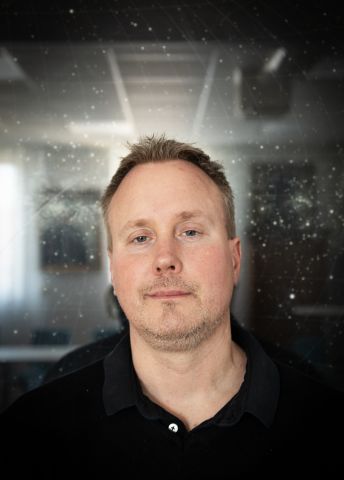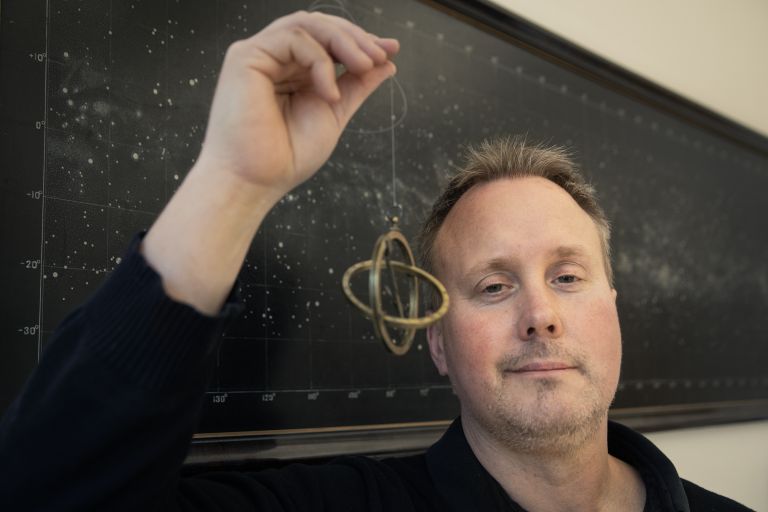
Oscar Agertz
PhD, Theoretical Physics
Wallenberg Academy Fellow, grant extended 2022
Institution:
Lund University
Research field:
Galaxy formation


Wallenberg Academy Fellow, grant extended 2022
Institution:
Lund University
Research field:
Galaxy formation
There are hundreds of billions of galaxies in the universe. Some resemble the Milky Way, shaped like a disk with spiral arms. Others are more like balls of stars or have bars in the center. Some lack any clear structure.
“It’s like a fantastic flora and fauna of galaxies, and this has been known for well over a hundred years. As far back as the early 20th century astronomer Edwin Hubble tried to classify them and understand how they related to each other. Which were formed first, and how were they formed at all?”
Agertz, who is an astrophysicist at Lund University, ponders the same questions as Hubble, but has much better tools at his disposal. He and his research team are now starting to study galaxy formation using a new simulation tool called genetIC.
“The simulation incorporates all the physics we know: gravity, relativity, hydrodynamics, i.e., how gases move. And how stars can explode into supernovae, and how they form heavier elements. That must also be included,” he says.
About twenty years ago, computers had become powerful enough to calculate how galaxies are distributed in the universe. But the simulations of that time were too simple to explain the differences between galaxies: why they were different sizes, had different shapes, and contained stars of varying sizes and masses. This is what Agertz is working on now, with much more computing power and enormous amounts of new data from modern telescopes. This makes the models much more detailed and accurate, and also allows collaborations between researchers with different interests.
“Better models enable us to combine fields that didn’t work together before. Now we can connect the scales so that cosmologists actually need to consider galaxies, and those of us who study galaxies must take account of individual stars. Those who study star formation must start thinking about planets...”
It is now possible to study how small processes affect large ones and vice versa. Agertz likens galaxy formation to a biological system. The process is governed by fundamental forces: genetics governs biology, and the laws of physics govern the universe. But individual events can also influence developments.
Technological advancements actually give us completely new ideas – they open the door to new approaches.
“Although the laws of physics apply, the life path of a galaxy plays a key role in shaping it. We want to be able to delve into our simulations and see what happens if we change something in the life path, such as removing a collision between two galaxies. It’s a kind of cosmological experiment in which we try removing certain physics to see if it was important.”
Traditionally, galaxy researchers have simulated many different galaxies to draw conclusions about how they were formed. This is a new approach: altering the history of individual galaxies.
“It’s like looking back on your own life: 'What if I’d left the party fifteen minutes earlier? I would have gone before that person arrived. Everything would have been completely different.”
The new models are being developed in collaboration with fellow researchers at Durham and Bath universities, where genetIC was developed. It has been complemented with the galaxy formation models that Agertz has developed in his research.
“We’re a great match. Now we have a much more controlled way of performing supercomputer simulations and can really customize galaxy formation.”
Agertz has been fascinated by the universe ever since he played with space-themed Lego in elementary school. He studied physics in Gothenburg and received his PhD in Zurich, where he specialized in computer simulations. From there, he moved on to research positions in Chicago and Surrey, England. Almost ten years ago he returned to Sweden, having been awarded his first grant as a Wallenberg Academy Fellow.
“I feel this is a friendlier field than it was fifteen or twenty years ago, with more collaboration. At that time, several groups aimed to create the first computer simulation of a Milky Way-like galaxy, and it was like a race – we jokingly called it a ‘galaxy formation war.’ There are other parts of astronomy that are in that stage now, with intense competition among just a few research teams. It’s not really like that for us anymore. I feel the field has matured.”
His long-term goal is to find out whether it is in fact possible to explain all the variations in galaxy formation using the data currently available. But he likes it when things don’t go as planned.
“We don’t know for sure which physics is important, because there is new physics that hasn’t even been discovered yet. For example, there seem to be large amounts of dark matter in the universe whose exact nature is still a mystery, but which has proven necessary for galaxies to form and hold together. My hope is that we create our models, and then nothing works. We can’t explain the observation. That’s when it will get interesting!”
Text Lisa Kirsebom
Translation Maxwell Arding
Photo Åsa Wallin